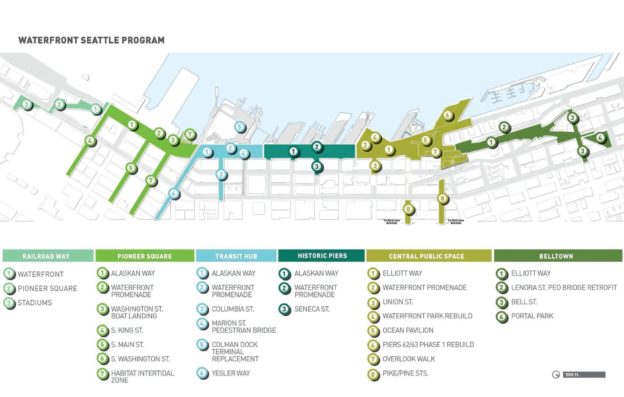A month ago I got a call from a civic leader I hugely admire asking me to join the board of Friends of Waterfront Seattle. I knew I’d say yes from the minute she asked; today that decision became official; this post explains why it matters and why you should care.
Friends of what?
Unless you’re a civics geek or long-time Seattle politics-watcher, you might not even know the Seattle Waterfront Project exists, much less what it includes. I won’t unpack the whole decades-long saga here, here’s all you really need to know:
- The Alaskan Way Viaduct — the elevated stretch of Highway 99 that separates downtown Seattle from the waterfront — is being town down in early 2019 (not much more than a year from now).
- When it comes down, for the first time in two generations (since Viaduct construction started in 1949), the downtown core will connect seamlessly to the water’s edge across 26 previously-blighted city blocks.
- For the last decade, a public-private partnership — with The Waterfront Seattle Program representing the City, and Friends of Waterfront Seattle as its private, non-profit counterpart — has worked tirelessly to set the stage for what’s about to happen.
Why does it matter?
Opportunities to create new public spaces at the heart of major cities don’t come along very often. In San Francisco, it took the massive Loma Prieta earthquake of 1989 to force the removal of the Embarcadero Freeway and spur the creation of a thriving pedestrian waterfront district. In New York City, community activists worked for decades to convert an abandoned elevated railway into the High Line, now one of the city’s most celebrated public spaces, attracting nearly 5 million visitors a year.
Here in Seattle, voters twice rejected Paul Allen’s attempt to give the city its own Central Park in the South Lake Union neighborhood in the mid-1990s. At the time, Seattle’s crime-burdened downtown was being abandoned by commercial tenants fleeing for the suburbs. Allen wound up developing the land as commercial office space, and in 2010 Amazon moved in, following up with a major land purchase in the Denny Triangle in 2012 that set the stage for the company’s massive expansion in the downtown core.
Today, Amazon employs over 30,000 people downtown, with plans to grow to 40,000 in the near future. 15% of those Amazon employees live downtown, and 20% walk to work. Our downtown has been transformed as a place to live and work, but still lacks a public space for that growing population to engage with the city and each other.
Why do I care?
I’m a Seattle native with deep roots in the Pacific Northwest, but spent most of my early career in in other cities – including two different stints in the Bay Area. I left San Francisco for the second time in 2001, having witnessed that city’s tech-fueled transformation into a glittering hub for the newly-rich. I returned to Seattle with a deep conviction that our region was poised to chart a different course: fully embracing its leadership role in the global economy, but blending that commitment to economic leadership with an equally deep focus on social justice and environmental stewardship over the long haul.
Amazon’s massive commitment to Seattle’s urban core, coupled with its transformational growth, have cast the challenges of maintaining this balance into sharp relief. Economically, Seattle is the envy of North American cities (the scramble over Amazon’s HQ2 is a useful data point here); but rising rents and home prices have made Seattle less affordable for those who don’t work in tech, hardening the battle lines between the pro-growth and social justice communities
The Seattle Waterfront Project offers a unique, once-in-a-generation opportunity to channel the massive energy of our city’s economic ascendance into a shared public good that will serve all Seattleites for generations to come. It is a chance for us to prove — to ourselves and to the world — that competing successfully in the global economy hasn’t come at the expense of our commitment to civic engagement.
Why should you care?
If you’re a Seattle native who’s concerned about where the city is headed and looking for ways to preserve our unique local culture, the Waterfront Project stitches together many our hardest-fought civic achievements — Pike Place Market, Pioneer Square, and the Seattle Art Museum’s waterfront Sculpture Park — into an integrated whole, reconnecting our pioneer and maritime heritage with the modern city.
If you’re new to Seattle and are looking for a way to participate in the city’s future, the Waterfront Project offers you an authorship role in a civic project that will be as deeply embedded in the city’s fabric and global brand as New York’s High Line or San Francisco’s Ferry Terminal are in those cities. You can help change Seattle’s urban landscape with the same lasting impact that Amazon has brought to its economic life, but in a way that’s available to all.
You can expect to hear more about this project in 2018 as planning kicks into high gear, but if you want to learn more please reach out to me directly or visit http://www.friendsofwaterfrontseattle.org/

